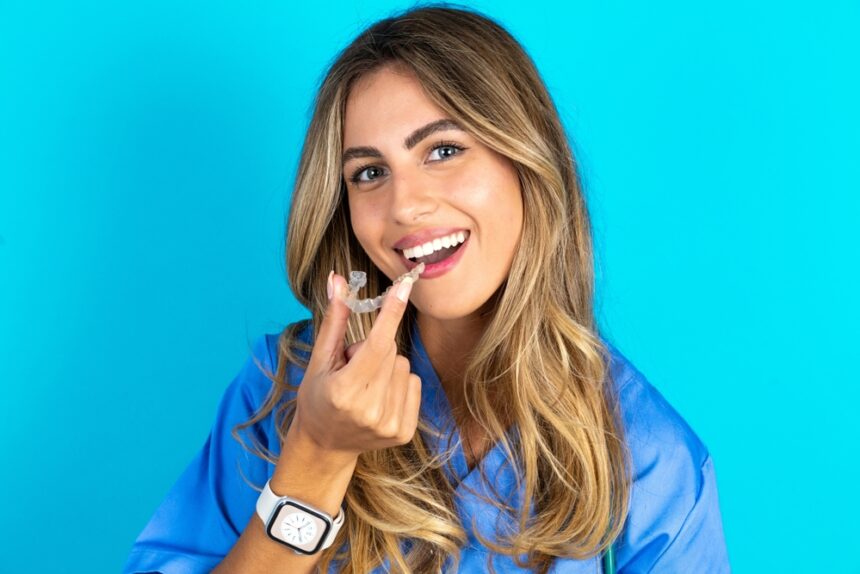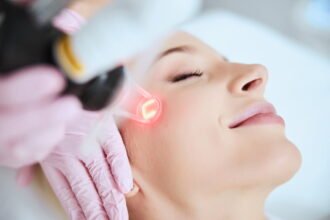When exploring orthodontic treatments, patients often weigh the pros and cons of Invisalign versus traditional braces. Both methods aim to correct dental alignment issues but employ distinct approaches with unique benefits and considerations.
This comparison delves into the fundamental differences between these two popular orthodontic solutions, providing insights to help individuals make informed decisions about their dental care.
Understanding Invisalign
Invisalign revolutionizes orthodontic treatment with its innovative approach, employing a sequence of transparent, detachable aligners meticulously crafted to conform to the individual contours of the patient’s teeth. This system eschews the conspicuous wires and brackets typical of conventional braces, instead opting for a nearly imperceptible solution that blends seamlessly with the natural appearance of the teeth.
Each aligner is fashioned using cutting-edge 3D computer imaging technology, guaranteeing a bespoke fit that enhances comfort and optimizes the effectiveness of the treatment process. This personalized approach facilitates a discreet, efficient path to achieving a straighter, more aligned smile.
Therefore, for those considering this modern approach to teeth alignment, exploring options like invisable aligners can provide a comprehensive understanding of what Invisalign involves, including its aesthetic and functional benefits.
The Basics Of Traditional Braces
Traditional braces have long been the cornerstone of orthodontic treatment, featuring metal brackets securely bonded to each tooth. These brackets are interconnected by wires, which an orthodontist adjusts periodically to apply a gentle pressure, methodically guiding teeth toward their optimal alignment. Recent innovations in orthodontic materials and techniques have enhanced braces’ comfort and aesthetic appeal.
Today, patients can choose brackets made from ceramic or colored materials that either blend with the natural color of teeth or add a personalized touch to their orthodontic experience. These advancements have made traditional braces a more appealing and less intrusive option for individuals seeking to correct their dental alignment.
The Key Differences Between Invisalign And Traditional Braces
Exploring the key differences between Invisalign and traditional braces reveals distinct approaches to orthodontic treatment, each with unique advantages tailored to diverse patient needs and lifestyles. Some key differences between Invisalign and traditional braces:
1. Aesthetic Considerations
The visual aspect is a pivotal factor when comparing Invisalign and traditional braces. Invisalign leverages clear, removable aligners that blend seamlessly with the teeth, offering an inconspicuous solution for straightening teeth. The clear and removable nature of Invisalign aligners is particularly appealing to adults and teenagers who might feel self-conscious about the noticeable appearance of metal braces.
On the other hand, traditional braces, characterized by their metal brackets and wires, are more evident. However, advancements such as ceramic braces have emerged, providing a less conspicuous option by mimicking the natural color of teeth, thus slightly mitigating the aesthetic concerns associated with traditional orthodontic appliances.
2. Treatment Flexibility And Discipline
Invisalign distinguishes itself with unparalleled flexibility, thanks to its removable aligners. This feature permits patients to maintain their usual dietary habits and uphold rigorous oral hygiene practices by allowing easy removal for eating, brushing, and flossing. Such flexibility, however, comes with the responsibility of wearing the aligners for approximately 22 to 24 hours daily to ensure the treatment’s effectiveness.
Conversely, traditional braces are permanently affixed for the treatment duration, simplifying compliance but introducing dietary limitations to prevent damage to the braces. This inherent difference between the two treatments underscores the balance between convenience and discipline required when choosing the appropriate orthodontic option.
3. Duration And Complexity Of Treatment
The treatment timeline is a critical aspect where Invisalign and traditional braces diverge significantly. Invisalign’s duration is generally shorter, ranging from 12 to 18 months, contingent upon the complexity of the dental correction required. Its efficacy is most pronounced in cases of mild to moderate misalignments.
Traditional braces, however, are typically worn for about two years, though this can extend longer depending on the patient’s specific orthodontic needs. This longer duration is often attributed to traditional braces’ capability to address a broader spectrum of orthodontic issues, including more severe misalignments and bite problems. This highlights the relationship between treatment complexity and duration.
4. Comfort And Maintenance
Invisalign aligners are made of smooth plastic, making them generally more comfortable than the metal brackets and wires of traditional braces, which can cause irritation to the cheeks and gums. However, both treatments may cause temporary discomfort following adjustments, as the teeth begin to shift.
Maintenance of Invisalign involves regular cleaning of the aligners. At the same time, traditional braces require meticulous oral hygiene to prevent food particles from getting trapped in the brackets and wires, potentially leading to plaque buildup and tooth decay.
5. Cost Considerations
The financial aspect of choosing between Invisalign and traditional braces is a significant factor for many patients. The overall expense is influenced by various factors, including the complexity of the case, the duration of treatment, and the geographic location of the orthodontic practice. Typically, Invisalign incurs higher costs due to the sophisticated technology involved in customizing each series of aligners.
Despite this, the gap in affordability between the two options has narrowed, thanks partly to dental insurance plans increasingly accommodating both treatments. This shift towards broader insurance coverage has made orthodontic care more financially accessible, allowing patients to select treatments based on preference rather than cost alone.
6. Suitability For Different Orthodontic Needs
When assessing the appropriateness of Invisalign versus traditional braces, the nature and severity of dental issues play a crucial role. Invisalign shines in correcting mild to moderate alignment problems, like overcrowding and gaps between teeth, and is effective for certain bite corrections.
Its less invasive approach, however, may fall short in tackling more complex orthodontic challenges that traditional braces can manage, such as significant malocclusions, intricate tooth movements, and the rotation of specific teeth like canines and premolars. This delineation highlights the importance of a thorough orthodontic evaluation to determine the most suitable method for each individual’s unique dental landscape.
Making The Right Choice
Choosing between Invisalign and traditional braces is a pivotal decision that hinges on a comprehensive evaluation by a qualified orthodontist. This professional assessment considers the intricacies of the patient’s dental condition alongside personal lifestyle needs, financial constraints, and aesthetic desires. The orthodontist’s expertise also enables a tailored approach, considering how each treatment aligns with daily routines, professional obligations, and social interactions.
Additionally, budgetary considerations and insurance coverage are scrutinized to ensure the chosen solution is financially viable. Ultimately, this collaborative decision-making process ensures the selected orthodontic treatment harmonizes with the patient’s overall well-being, cosmetic concerns, and long-term dental health objectives.
Conclusion
By keeping the information mentioned above in mind, patients will understand that both Invisalign and traditional braces offer effective solutions for correcting dental misalignments, each with its own set of advantages and considerations. However, it’s essential to know that the decision should be based on a thorough evaluation by an orthodontic professional, who can guide patients toward the most suitable treatment path for achieving a healthy, aligned smile.









